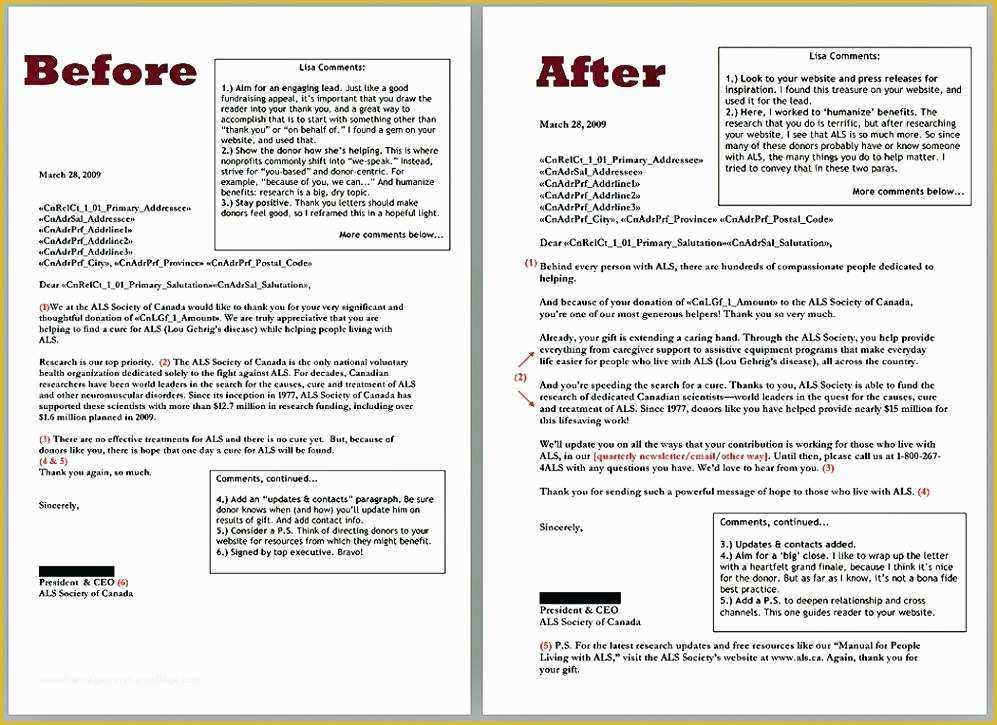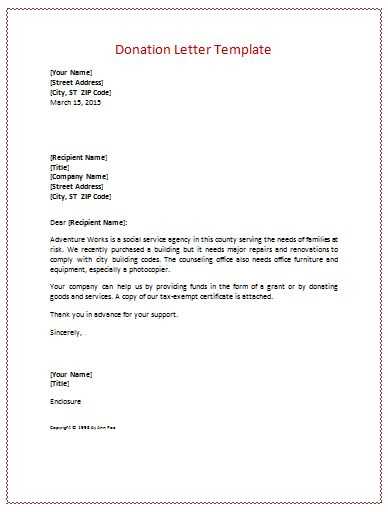Fundraiser template letter

Use a concise, clear, and direct approach when crafting your fundraising letter. Start with a compelling opening that quickly engages the reader, clearly explaining your cause and the specific support you need. Avoid lengthy explanations or general background information that can dilute the impact of your message.
Be specific about the goal. Instead of general appeals for donations, state a clear financial target or itemized need. This helps the reader understand exactly how their contribution will make a difference. For example, if you’re raising funds for a community project, mention how much you need to cover materials or specific activities.
Personalize the letter. Address the recipient by name whenever possible. Tailor the message to their interests or past involvement, making it feel less like a mass appeal. This creates a stronger connection and increases the likelihood of receiving support.
Conclude with a simple call to action. Whether it’s a link to donate online or details for mailing a check, make it easy for the reader to take immediate action. A clear and accessible next step removes barriers and encourages prompt responses.
Fundraiser Template Letter Guide
Focus on clarity and sincerity when drafting your fundraiser template letter. Start by clearly stating the purpose of your campaign and how the funds will be used. Be specific about your goal and share the impact that the donations will make.
Personalize Your Message
Personalizing your letter helps build a connection with potential donors. Address the recipient by name and, if possible, include any previous interactions or common interests. Mention how their support can directly contribute to the success of your cause.
Call to Action
End with a strong, direct call to action. Make it clear what steps the recipient should take to contribute. Whether it’s a link to an online donation page or instructions for sending a check, provide clear details. Reassure them that any amount helps and that their contribution makes a difference.
How to Start Your Fundraising Appeal
Begin with a compelling opening that connects emotionally with your audience. Explain the cause clearly and concisely, stating why it matters. Avoid jargon–use simple language that everyone can understand. Share a personal story or statistic that highlights the urgency of the need.
Craft a Strong Call to Action
Your appeal should include a direct request. Be specific about how much money is needed and what it will accomplish. Acknowledge that even small contributions make a difference. Make it easy for people to act by providing clear instructions for donation methods and deadlines.
Highlight the Impact
Show how donations will directly benefit the cause. Be transparent about how funds will be used. People are more likely to contribute when they see tangible results. Include testimonials or examples of past successes to demonstrate credibility.
Creating a Compelling Story for Donors

Begin with a strong, emotional opening that immediately connects with your audience. Highlight a real-life example or a specific person who will benefit from the donation. Make it relatable by describing their challenges and the impact that donations can make in their lives.
Focus on Personal Connection
Paint a picture of the situation using vivid details. People are moved by stories that evoke empathy. Share how their contributions will create meaningful change, whether it’s providing a child with school supplies or supporting someone’s medical treatment. Show them how their role matters and make it clear that they are not just helping, but changing someone’s life.
Highlight the Immediate Impact
Donors need to understand the direct effect of their support. Be specific about how the funds will be used. Will their donation provide meals, shelter, or education? Keep it simple but clear–let donors feel confident that their gift is being used where it is most needed.
Don’t forget to express gratitude. Show donors they are part of something larger, but emphasize their individual importance in the mission. Acknowledge their contribution as key to achieving success and creating lasting change.
Personalizing Your Fundraiser Letter
Begin with a personal greeting. Use the recipient’s name instead of a generic salutation. A direct address immediately creates a connection and increases the likelihood of engagement. Reference the recipient’s previous support or interest in your cause if applicable, highlighting their contribution or involvement to make them feel recognized.
In the body, tailor the content to reflect the donor’s interests. If they have supported similar causes in the past, mention how their past generosity has made a difference. Highlight specific goals your organization is working towards, explaining how their help can make an impact. Customize the ask to reflect the recipient’s giving history or preferences, ensuring the message feels relevant.
End with a personal sign-off. Thank them for their time and consideration, and offer your contact details in case they have any questions. Reinforce that their support is valued, making it clear you appreciate their commitment to your cause.
Including Clear Donation Instructions
Provide specific details on how donors can contribute. Use clear instructions for various payment methods, such as online platforms, checks, or bank transfers. If using a donation platform, include a direct link to the donation page with step-by-step guidance. If donors can give by check, specify the payee name and mailing address. For bank transfers, provide the account number and routing information. Avoid ambiguity by using concise, simple language, making it easy for anyone to follow.
Break down the donation process into simple steps to eliminate any confusion. For example: “1. Visit our donation page at [link], 2. Enter your contribution amount, 3. Complete the transaction.” Always include contact information for any questions or issues related to donations. This creates trust and reduces hesitation.
Building Trust Through Transparency
Openly share how the funds will be used. Break down the allocation in a clear and understandable format. This will show donors exactly where their contributions are going and how it supports the cause. Transparency in financial matters strengthens relationships and reassures supporters about the integrity of the fundraising effort.
Share Specific Budget Details
Provide a detailed budget plan that explains all expenses, from administrative costs to project funding. This transparency builds confidence and demonstrates responsible management. Donors appreciate seeing their money spent wisely and in alignment with your mission.
| Expense Category | Amount | Percentage |
|---|---|---|
| Program Expenses | $5,000 | 50% |
| Marketing and Outreach | $2,000 | 20% |
| Administrative Costs | $1,500 | 15% |
| Fundraising Expenses | $1,000 | 10% |
| Miscellaneous | $500 | 5% |
Provide Regular Updates

Keep your donors informed by sending progress reports that show how their donations are making a difference. Highlight key milestones and offer insights into the impact of the funds raised. Donors want to feel connected to the success of the initiative, and regular updates help maintain this bond.
Follow-up Strategies for Increased Support
Timing is key in follow-ups. Reach out within a week of your initial letter to remind recipients of your cause and progress. A prompt follow-up shows that you value their potential support and helps keep the momentum going.
Personalize your messages. Address each recipient by name and reference their previous engagement, whether it’s a past donation, attendance at an event, or interest in your cause. Personal touches create a stronger connection and increase the likelihood of a positive response.
Be clear about the impact of their contribution. Let them know exactly how their support will make a difference. Whether it’s funding a specific program or providing essential resources, people want to know how their donation will be used.
Use multiple communication channels. In addition to emails, consider reaching out through social media, phone calls, or even handwritten notes. Different platforms can make your message more accessible and engage a broader audience.
Offer multiple ways to contribute. Provide different donation tiers or volunteer opportunities. Some supporters may prefer a one-time donation, while others might be interested in recurring contributions or hands-on involvement.
Highlight success stories. Share how previous donations have made an impact, whether it’s a project completed or a person helped. Testimonials and stories from those directly benefited can make your case more compelling.
Keep it brief but informative. Respect people’s time by keeping follow-up messages concise while still delivering necessary information. Make it easy for them to act by including a clear call to action, such as a donation link or sign-up form.
Track responses and adjust. Monitor who opens your messages, clicks on links, or responds. Adjust your follow-up approach based on the level of engagement, ensuring that those who show interest receive more detailed updates.